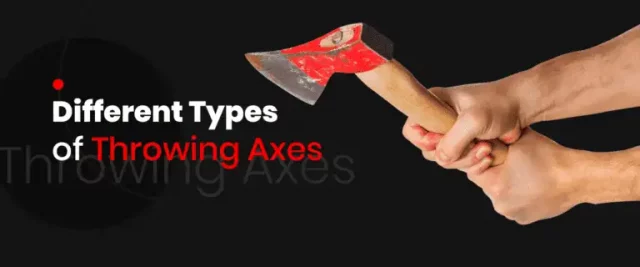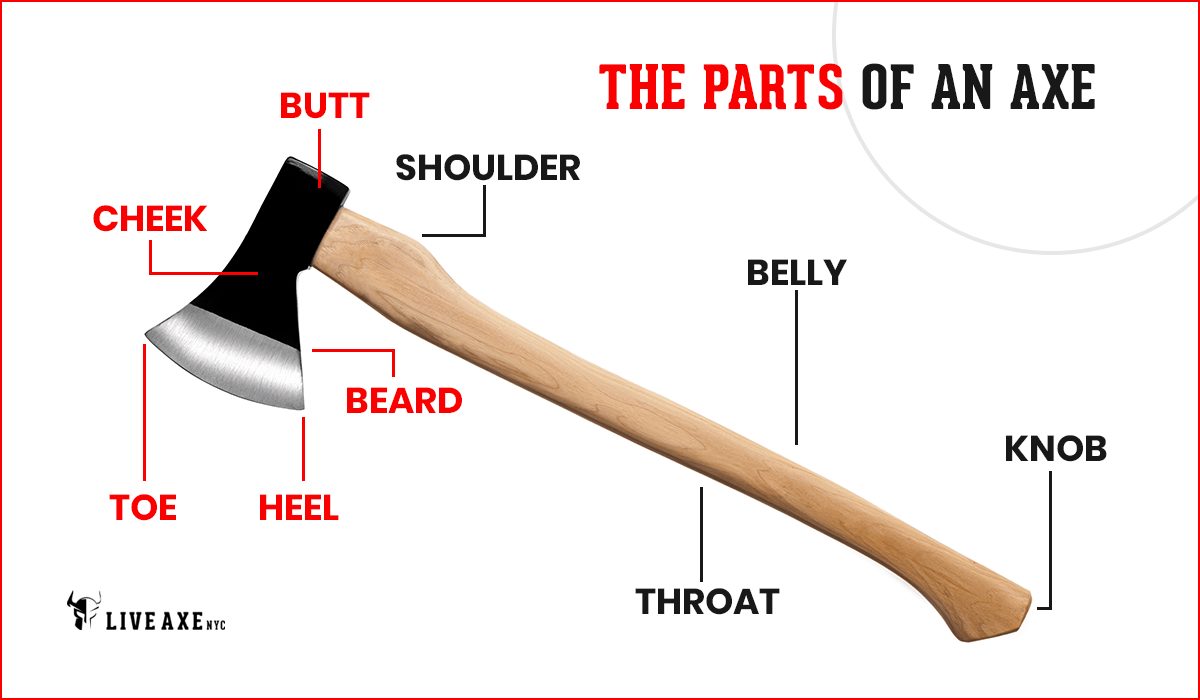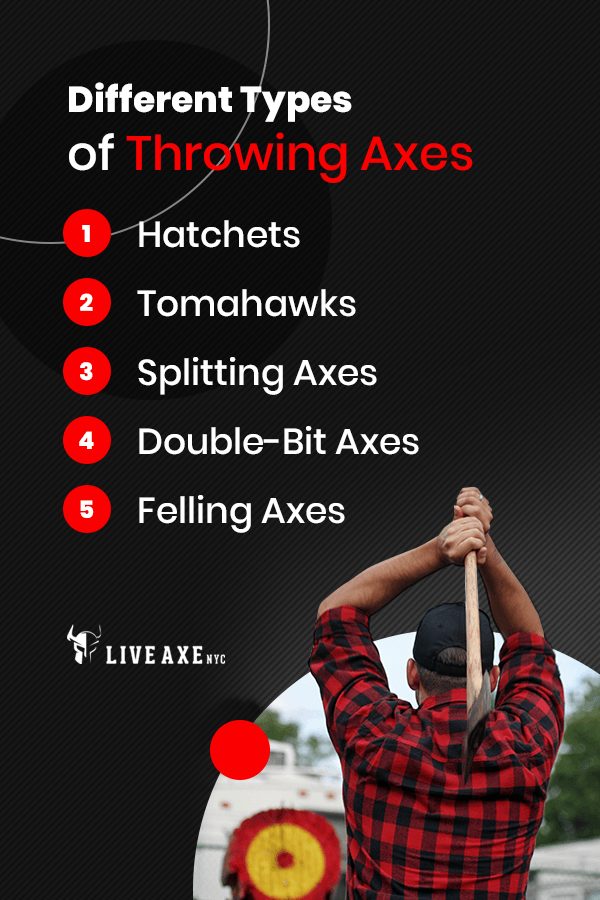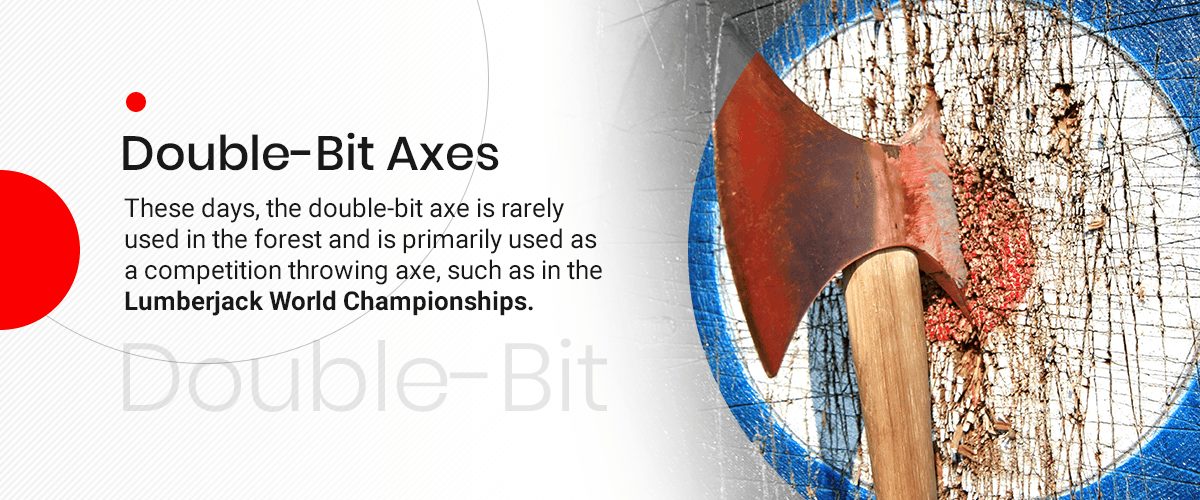In the past 10 years or so, recreational axe throwing has gone from a pastime for lumberjacks to an international phenomenon. Organizations like the International Axe Throwing Federation (IATF) and World Axe Throwing League (WATL) have emerged, and venues featuring this recreational activity can now be found in many major cities in the United States and Canada....
Different Types of Throwing Axes


In the past 10 years or so, recreational axe throwing has gone from a pastime for lumberjacks to an international phenomenon. Organizations like the International Axe Throwing Federation (IATF) and World Axe Throwing League (WATL) have emerged, and venues featuring this recreational activity can now be found in many major cities in the United States and Canada.
If you’re interested in trying your hand at this new sport, read our guide first, where you’ll learn about all the parts of an axe and the various types of axes for axe throwing.


The Parts of an Axe
Before going into the differences between throwing axe types, we’d first like to acquaint you with the different components of an axe. The two main parts of an axe are the head and the handle, which we’ll discuss in detail below:
1. Axe Head
An axe head has two ends — the bit on one side and the butt on the other. Often called the axe’s “business end,” the head serves as a mechanical wedge. The sharpness of the bit, combined with the user’s kinetic energy, makes the axe an effective and extremely versatile tool. There are many types of axes, including hatchets, splitting axes, felling axes and carpenter’s axes, and each one has a specialized head shape that helps it achieve its purpose.
The bit, also known as the edge or the blade, is what does the cutting. This part is considered the single most important part of an axe. Keeping it sharp is critical for the durability and efficiency of the axe. Other parts of the axe head include the:
- Toe: The toe refers to the bit’s upper corner. If you’re throwing an axe, it is this section that you want to hit your target with.
- Heel: The heel is the bit’s bottom corner, which sometimes extends below the other parts of the axe head. In some jobs, the heel is used for detail-oriented work such as carving. You can also use it to puncture objects.
- Beard: If the heel descends below the other parts of the axe head, it is known as the beard and encompasses the bit’s heel section.
- Cheek: The axe cheek refers to the smooth areas on the sides of the axe head. Although not sharp, this area can be used in many different ways. An axe’s cheek comes in a wide variety of inclines. If the incline of the cheek is sharper, then chopping is easier, but it also means that the axe will be less durable. If the incline of the cheek is less sharp, it can be used in other ways, such as removing the bark from tree limbs.
- Butt: The blunt end of the axe head is referred to as the butt. This portion helps the user with control and balance, but it also has various other uses, including as a maul or a hammer.
2. Axe Handle
The handle is, of course, the part of the axe that you hold. This component is integral to the weight, durability and comfort of an axe and is typically made of a spring hardwood like hickory, but it’s sometimes made of synthetic materials instead.
If you’re shopping for an axe, pay special attention to the handle. When inspecting a handle made of wood, make sure the grain is straight and contains no knots. If you’re looking at an axe with a synthetic handle, ensure that its construction is solid, as uncomfortable handles can lead to fatigue and possibly injury.
One component of the handle is the eye, which refers to the hole where the handle connects to the head. Despite being called the eye, most of it you cannot see, and the only portion that is usually visible is above the bit. The axe’s eye secures the head to the handle, and it is the component that most frequently breaks, although there are many ways to repair it.
Other components of the handle include the:
- Shoulder: The axe’s shoulder is where the axe handle material meets the axe head material. Pay particular attention to this area, as decoupling is sometimes an issue.
- Belly: The belly of the axe, which is opposite to the bit, is the longest part of the handle and often features a subtle bow. Before buying an axe made of wood, inspect the grain in the belly of the axe and make sure it’s straight and there are no knots or signs of wood degradation. If there are, this is a sign of a lower-quality axe and could lead to problems.
- Throat: An axe’s throat refers to the transition area between the belly and the short grip. This area’s design is critical for both the comfort and durability of the axe. If the throat on your throwing axe is uncomfortable, your hands may end up feeling fatigued and sore. When shopping for an axe, pay attention to the throat, as it can affect whether you can throw it with accuracy or not.
- Knob: The knob refers to the end of the handle opposite of the head. Although frequently overlooked, the knob can help indicate the quality of the wood. It’s sometimes coated in lacquer or paint.


Different Types of Throwing Axes
Hundreds of axe types have been used throughout human history, although some are better for throwing than others. In this section, we’re going to discuss what types of axes are used for throwing:
1. Hatchets
There are many different types of hatchets, each of which has a specific use. Small hatchets, also known as forest axes, are generally designed to cut through tree branches and other small obstacles. They tend to weigh only a few pounds, and their length is around a foot, sometimes a little more.
Hatchets are considered a general all-purpose axe and are the kind that many people use for light jobs around their property. They are small compared to many other types of axes and feature a chunky handle commonly made of hickory. The head of a hatchet is weighted and features a sharp blade. A high-quality hatchet has a balanced feel, which helps the user swing and cut accurately.
Small hatchets are the main kind of axe used for axe throwing. They’re easier to throw than most other axes types, making the activity enjoyable for beginners. The IATF requires this type of throwing axe and requires the hatchet to meet the following conditions:
- Material: The handle of the axe must be made from wood. No other materials are allowed.
- Blade type: The blade of the axe must be single-bit. No sharpened spike or blade can protrude from the back of the axe head.
- Handle length: The handle’s length must be at least 13 inches long but cannot exceed 17 inches. This measurement is from the bottom of the axe handle to the axe head’s top.
- Weight: The head of the axe must weigh at least 1.25 pounds but not exceed 1.75 pounds. Officials or referees determine an axe’s weight by referring to its advertised or stamped weight, but if this is not available, the official or referee may weigh the axe with the handle to find out its combined weight.
- Length of blade: The axe’s blade must not exceed 4 inches in length and must be fixed to the axe handle.
2. Tomahawks
The tomahawk, which is generally lighter and thinner than a hatchet, was created and first used by Native American tribes, although their tomahawks were not originally made with metal. Before the Europeans arrived in the New World, Native Americans had never even seen iron tools. After the Europeans conquered the continent, they traded with the natives, and “trade axes” played a significant role. Relatively light and small axes that could be easily attached to the belt were popular among Europeans, and they quickly became popular with the Native Americans as well, who used them for hunting, fighting and domestic work.
This type of axe, which has been given the collective name “tomahawk,” has become a symbol of Native Americans, largely due to an inaccurate image of these tribes propagated by European colonists and, later, Hollywood.
Today, tomahawks have many uses. They are similar to hatchets in that they can be used for simple camping tasks and for cutting through tree branches and brush. However, their smaller size and lightweight nature make them preferable to hatchets in many situations.
Their versatility also makes them useful in specific wartime operations. Tomahawks feature a straight handle, which allows them to be released easily to throw at an enemy in combat.
Tomahawks are also frequently found in axe throwing establishments, although hatchets are more common.
3. Splitting Axes
Splitting axes, also known as splitting mauls, are primarily used for splitting and chopping up firewood. They feature a long wooden handle, which gives the user the leverage needed to produce a powerful swing. When you use a splitting axe, your swing should be downward, not sideways, as is the case with a felling axe.
Splitting axes also have a heavy, large head ground into a concave shape with a somewhat thin edge. The splitting axe’s concave shape makes sure that the edge goes easily and quickly into the wood and then splits it as the wider part of the axe head pushes the wood apart. This design also keeps the axe head from sticking easily into the wood, which is what would happen with slimmer axe heads.
This axe is designed to cut along the grain, unlike hatchets and felling axes, which are designed to cut across the grain.


4. Double-Bit Axes
This double-edged axe was most often used by forest workers in the United States and Canada up until the chainsaw superseded it in the middle of the 20th century. It features two edges, one ground finely and the other a little bit blunter. The finer edge was used for felling trees, whereas the other one was meant for limbing. In other words, it doubled as both a felling axe and as a hatchet, which allowed workers to do everything they needed without lugging around two axes. The double-bit axe became so widespread that it even came to be a symbol of North American forest workers.
As the forest workers who used these axes typically worked in remote areas for several months at a time and didn’t have a wide variety of entertainment options, they would often spend their leisure time throwing these axes at targets, usually the ends of logs.
These days, the double-bit axe is rarely used in the forest and is primarily used as a competition throwing axe, such as in the Lumberjack World Championships.
5. Felling Axes
Felling axes are designed specifically to fell trees and chop wood logs. A felling axe features a long handle and head weighing several pounds. The felling axe’s long handle gives the user more leverage, allowing them to swing with more power and make a better cut. Felling axe handles have traditionally been made of hickory wood, one of the strongest woods available. If shopping for a felling axe, make sure the wood grain follows the axe handle lengthways and curves with it, as this will ensure superior strength.
Felling axes feature blades with a thin and sharp tip, which are designed for cutting against the grain. Therefore, if felling a tree, swing the axe sideways at the trunk. Felling axes are great for felling branches and small trees but do not work well for splitting, as the sharp blade will easily get stuck.
Although felling axes’ size and weight do not make them one of the best throwing axe types, they are actually used in “big axe throws,” which serve to break ties in IATF-sanctioned axe-throwing competitions.
According to the IATF, the head of a felling axe used in a big axe throw must weigh between 2.25 and 2.75 pounds, and the length of the handle must be a minimum of 25 inches, which includes the handle in the blade’s eye.
Sharpen Your Axe Throwing Skills at Live Axe
Now that you’ve learned about the different types of axes, get ready to put your skills to the test. If you’re in or around New York City, drop by Live Axe to enjoy a night of delicious food and exhilarating axe-throwing fun. Bring all your friends for an unforgettable party or unleash your inner Viking by joining an axe-throwing league. You can book a reservation by calling us at 888.812.9060 or filling out our online form.

